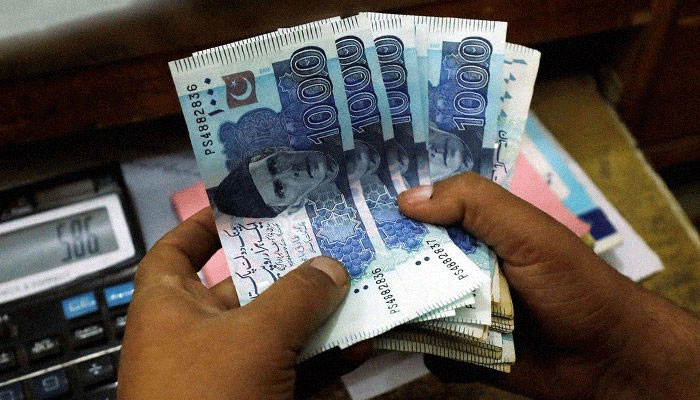Bank deposits increase 18.5pc to Rs16.5trln
KARACHI: Bank deposits stood at Rs16.5 trillion at the end of November, up 18.5 percent from Rs13.9 trillion in the same month of last year, the central bank’s data showed on Friday.
Deposits stood at Rs16.3 trillion in the previous month, according to the State Bank of Pakistan’s (SBP) data.
Resident deposits rose to Rs16.1 trillion till the end of November from Rs13.6 trillion a year earlier. Non-resident deposits increased to Rs330 trillion from Rs254 trillion.
Government deposits stood at Rs2.3 trillion compared with Rs2 trillion in the corresponding month last year. Personal deposits rose 21 percent to Rs8.3 trillion. Private sector deposits grew 23.6 percent to Rs3.5 trillion.
The main drivers for the increased deposits accumulation are higher money supply growth and acceleration in the deposit of individual account holders.
M2 clocked in at Rs21.1 trillion, up 17 percent a year earlier.
The spike in net domestic assets of the banking system also contributed to deposit growth. The key factor behind the expansion in NDA was an increase in the government’s budgetary borrowings from the scheduled banks. NDA stood at Rs21.1 trillion compared with Rs19.1 trillion.
Deposits are expected to maintain the upward trajectory in the coming months as banks make effort to mobilise higher funds to achieve the deposit target set for year-end.
However, the expected increase in interest rates may dent the deposit growth next year.
The economy’s cash preference has increased manifold in recent years, especially relative to the increase in bank deposits, since the imposition of withholding tax on banking cash and non-cash transactions. The higher currency to deposit ratio is a source of concerns for the analysts at the central bank.
At end June 2020, this ratio touched 41.7 percent – a level last seen in FY92. The currency in circulation clocked in at Rs6.442 trillion as on September 30, 2020.
Meanwhile, the increase in currency in circulation may also reflect the impact of cash disbursements under the government’s Ehsaas Emergency Cash program (to the tune of around Rs150 billion up to June 30) to support families facing extreme financial hardship, it noted.
Nonetheless, the steady increase in cash penetration in the economy is concerning as, compared to other emerging market economies, it is already on the higher side in Pakistan.
The currency to deposit ratio in Pakistan is significantly higher compared to India and Egypt, almost double as compared to Bangladesh, Indonesia and Turkey, and over 4-times the ratio in Malaysia and South Korea. The surge in the use of the paper-based means of performing transactions is backed by the easing of lockdown. The paper-based transactions rose 24 percent in volume to 97.1 million in July-September FY2021 from 75.8 million in the previous quarter. These transactions recorded at Rs36 trillion in July-September FY2021 period, compared with Rs29.8 trillion in April-June FY2020.
-
 Brooklyn Beckham Finds It 'hard' To Keep Contact With Sister Harper
Brooklyn Beckham Finds It 'hard' To Keep Contact With Sister Harper -
 New Mystery About 'Ring Nebula' Shock Astronomers: Here's Why
New Mystery About 'Ring Nebula' Shock Astronomers: Here's Why -
 Prince Harry Picks PR Photos In Fear Of ‘bald Spots’
Prince Harry Picks PR Photos In Fear Of ‘bald Spots’ -
 Saying Prince Harry Will ‘probably Be Fine Isn’t Good Enough’, Expert Speaks Out
Saying Prince Harry Will ‘probably Be Fine Isn’t Good Enough’, Expert Speaks Out -
 Inside Meghan Markle’s Plans ‘With Love, Meghan’: Season 3 And Valentines Day Specials
Inside Meghan Markle’s Plans ‘With Love, Meghan’: Season 3 And Valentines Day Specials -
 King Charles Gets Caught Between A Rock And A Hard Place For The Second Time With Harry
King Charles Gets Caught Between A Rock And A Hard Place For The Second Time With Harry -
 Dolly Parton Hints At More Music As She Marks 80
Dolly Parton Hints At More Music As She Marks 80 -
 Simu Liu Reveals How His Family Treated Him After He Started Acting
Simu Liu Reveals How His Family Treated Him After He Started Acting -
 Gwyneth Paltrow Mourns Valentino As She Calls His Death 'end Of An Era'
Gwyneth Paltrow Mourns Valentino As She Calls His Death 'end Of An Era' -
 Prince Harry Questioned Over Desires Of Becoming ‘next King’
Prince Harry Questioned Over Desires Of Becoming ‘next King’ -
 Three-year-old Allegedly Tortured, Killed During Exorcism In California Church
Three-year-old Allegedly Tortured, Killed During Exorcism In California Church -
 Blake Lively Gushes She And Ryan Reynolds Are 'partners In Everything'
Blake Lively Gushes She And Ryan Reynolds Are 'partners In Everything' -
 Teyana Taylor Reflects On Co-parenting Journey With Ex Iman Shumpert
Teyana Taylor Reflects On Co-parenting Journey With Ex Iman Shumpert -
 Blake Shelton Recalls Being 'nervous Wreck' On Adam Sandler Film
Blake Shelton Recalls Being 'nervous Wreck' On Adam Sandler Film -
 Prince Harry's Lawyer Tells Court Daily Mail Complicit In Unlawful Acts
Prince Harry's Lawyer Tells Court Daily Mail Complicit In Unlawful Acts -
 Meghan Markle Named In Epstein Files With Ghislaine Maxwell?
Meghan Markle Named In Epstein Files With Ghislaine Maxwell?




